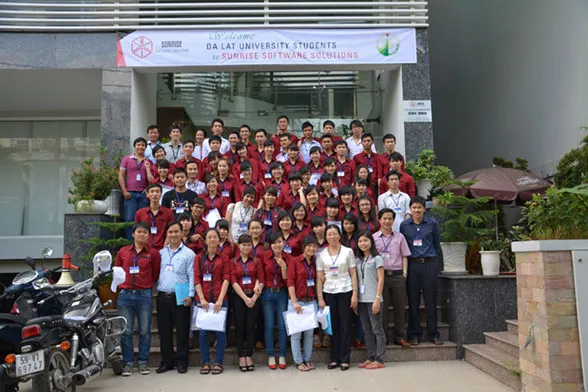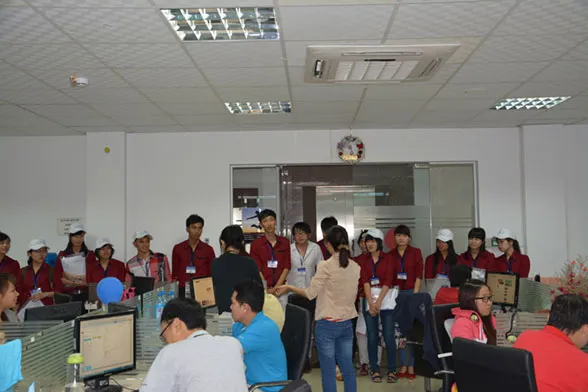Da Lat University Students at S3Corp.

News
Table Of Content
Da Lat University Students Visit S3 Corp.: Gaining Insight into Real-World Software Development
Purpose of the Visit: Academic Exposure to Industry Practices
Introduction to the Software Outsourcing Industry
Understanding the Corporate Work Environment
Exposure to Development Processes and Tools
Commitment to Knowledge Sharing
Real-Life Career Paths
Conclusion: A Valuable Step in Career Preparation
Da Lat University Students Visit S3Corp.
On Friday, November 8, 2013, students from the Math and Computer Science Department at Da Lat University visited S3 Corp. This visit provided them with direct exposure to how a software company operates. The visit focused on learning through observation and interaction, helping the students understand work environments and industry expectations. The visit served as an essential step in connecting their academic knowledge with real business operations.
08 Nov 2013
Da Lat University Students Visit S3 Corp.: Gaining Insight into Real-World Software Development
On Friday, November 8, 2013, students from the Math and Computer Science Department at Da Lat University visited S3 Corp. This visit provided them with direct exposure to how a software company operates. The visit focused on learning through observation and interaction, helping the students understand work environments and industry expectations. The visit served as an essential step in connecting their academic knowledge with real business operations.
Purpose of the Visit: Academic Exposure to Industry Practices
Company visits form an official part of the college curriculum at Da Lat University. These visits aim to introduce students to working environments within their field of study. The goal is to help students understand what companies expect from software professionals before they complete their degrees. By joining this visit, the students moved beyond theory and gained a clearer picture of actual software development work. The company environment showed them what teams look like, how departments collaborate, and what tools and methods professionals use daily. This helped prepare them for internships or jobs after graduation.

Introduction to the Software Outsourcing Industry
During their time at S3Corp., the students received guidance from Mr. Thanh and Ms. Ha. Both are Da Lat University alumni and now full-time employees at S3 Corp. Their presence added value to the visit by allowing students to connect with people who once stood where they are now. These alumni shared their career journeys, explained their daily tasks, and answered specific questions about work-life at S3 Corp. This direct peer link between students and professionals gave the visit a more personal and relatable dimension.
The main focus of the session was on the software outsourcing industry. Mr. Thanh and Ms. Ha explained what outsourcing means in software, how S3 Corp. serves clients, and what roles software engineers play in outsourced projects. The students learned about the structure of outsourced work, including communication with clients, requirement analysis, project planning, software development, testing, and delivery. This overview helped them understand how outsourcing functions in real time, outside textbook definitions.

Understanding the Corporate Work Environment
After the orientation and discussion session, the students joined a guided tour of the S3 Corp. office. This tour allowed them to explore the physical layout of a working software company. They saw different departments in action, such as development teams, testing areas, and support units. They also observed how teams coordinate tasks and maintain workflow within the workplace. The tour helped the students visualize how space is organized to support productivity and collaboration in a tech company.
During the tour, they met with several managers and engineers. These professionals explained their responsibilities and shared information about ongoing projects. Each interaction gave the students a broader view of roles in a software company. The engineers discussed how they organize code, manage data, track bugs, and communicate updates. Managers talked about time management, performance metrics, and client communication. These interactions clarified job functions that students usually only learn about in theory.
Exposure to Development Processes and Tools
The students expressed strong interest in learning about the software development process. They asked many questions related to development cycles, project planning, programming tools, and testing methods. The engineers at S3 Corp. responded with clear explanations. They walked the students through development stages like planning, coding, testing, and maintenance. They also described the use of tools such as version control systems, task management platforms, and debugging environments.
The students were particularly curious about Agile methods and how teams apply them to real projects. The engineers described how they break projects into sprints, assign tasks to members, and track progress with daily stand-ups and sprint reviews. This breakdown of project management provided practical context to what students had previously studied in theory. The explanation also covered how teams ensure quality by writing test cases, conducting peer reviews, and following best practices.
Commitment to Knowledge Sharing
Despite busy schedules and ongoing project commitments, S3 Corp. engineers and managers made time to interact with the students. They welcomed questions, shared experiences, and explained technical and non-technical aspects of their jobs. This effort reflected the company’s interest in supporting future tech professionals. The team understood the importance of creating learning opportunities and made sure the students left with useful insights.
The students appreciated this openness and felt encouraged to pursue careers in software development. Seeing the tools in use, hearing real case examples, and speaking directly with professionals helped them connect academic knowledge with workplace reality. It also made them aware of skills they need to focus on in their remaining college years.
Real-Life Career Paths
The presence of alumni in the session played a significant role in shaping the visit experience. Mr. Thanh and Ms. Ha, who once studied at the same university, represented achievable success. Their stories were specific and relatable. They talked about how they transitioned from students to full-time developers, what challenges they faced, and how they adapted to work life. They also shared advice on how to prepare for internships and entry-level positions. Their experience gave the students a clear roadmap for entering the industry.
Students asked them about their first projects, their learning process, and how they improved their skills after graduation. The answers were straightforward and based on real-life work scenarios. This exchange allowed students to understand that technical knowledge must be combined with communication, problem-solving, and continuous learning to succeed in the software field.
Conclusion: A Valuable Step in Career Preparation
The visit to S3Corp. gave the students from Da Lat University direct exposure to the software development industry. They gained valuable insights into software outsourcing, project management, technical workflows, and the corporate environment. They also built connections with alumni who serve as examples of career growth. Every part of the visit was structured to provide clear, useful, and practical knowledge.
This experience will help students better understand what is expected of them in the industry. It will also guide them as they make decisions about internships, final-year projects, and future employment. The visit successfully bridged the gap between classroom learning and workplace reality, offering students a strong starting point for entering the software field.


_1746790910898.webp?w=384&q=75)
_1746790956049.webp?w=384&q=75)
_1746790970871.webp?w=384&q=75)



